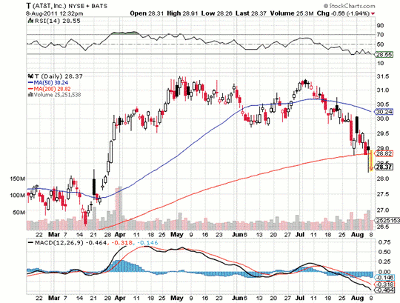Telecom giant AT&T (T) is fundamentally strong, pays a healthy dividend, and has exciting growth prospects in the wireless sector. Look for a favorable buying opportunity in the current market downturn.
AT&T (T) is a shadow of its former self. Until a judge broke it up in the mid-1980s, it controlled most telephone traffic. But after spinoffs and acquisitions, AT&T is on the prowl for growth. Should you buy it?
In 1982, Judge Harold Green negotiated an antitrust settlement with AT&T, resulting in a breakup of the company. That created a tidal wave of consulting work that kept me busy for years. I helped AT&T develop new systems to measure customer satisfaction and sales productivity and analyzed the profit potential of the long-distance telecommunications industry.
But that’s ancient history. Since then, AT&T spun off its local telecom subsidiaries in 1984, then reacquired some of them. For example, in 2005, it bought SBC Communications—which included its former Southwestern Bell subsidiary—after its 2000 deal to acquire MediaOne, a cable company. And in March 2011, it announced a deal to acquire T-Mobile for $39 billion in a bid to boost its fast-growing wireless business.
So, should you buy AT&T stock or avoid it?
Well, here are three reasons to consider buying:
- Attractive dividend. AT&T has a 5.95% dividend yield—a very strong reason to buy the stock.
- Meeting or beating earnings expectations. AT&T has beaten or met analyst expectations in all of the last five reporting periods. In its 2011 second quarter, AT&T reported 60 cents in adjusted earnings per share (EPS), one cent above analyst expectations. Its mobile broadband growth, strong smartphone sales, and stable wireline revenues contributed to the better growth.
- Out-earning its cost of capital. AT&T is earning more than its cost of capital—and it’s improving. How so? It produced positive EVA momentum, which measures the change in “economic value added” (essentially, after-tax operating profit after deducting capital costs) divided by sales. In the first six months of 2011, AT&T’s EVA momentum was 2%, based on first six months’ 2010 annualized revenue of $122.7 billion, and EVA that rose from -$331 million annualizing the first six months of 2010 to $1.5 billion annualizing the first six months of 2011, using a 6% weighted average cost of capital.
NEXT: Two Potential Downside Pressures to Watch
|pagebreak|However, here are two potential reasons to avoid this stock:
- Rapidly rising sales and profits, but a weaker balance sheet. AT&T has been growing with declining margins. Its $124.3 billion in revenues have grown at an average rate of 18.5% over the past five years, while its net income of $19.1 billion has tumbled at a 26.8% annual rate during that period—yielding a high 15% net profit margin. Its debt has grown while its cash has tumbled. Specifically, its debt has grown at a 4.2% annual rate, from $50 billion (2006) to $59 billion (2010), while its cash has fallen at a 12.6% annual rate, from $2.4 billion (2006) to $1.4 billion (2010).
- Slightly elevated valuation. AT&T’s price/earnings-to-growth ratio of 1.10 (where a PEG of 1.23 is considered fairly priced) means it is a bit overvalued. It currently has a P/E of 8.7 and is expected to grow 7.1% to $2.54 in 2012.
Here is a daily chart below. Yesterday’s market action improves those numbers above even more:
AT&T is a very strong company, and the current market turmoil should present investors with a chance to buy the stock at a lower price.
By Peter Cohan of InvestorPlace.com






















